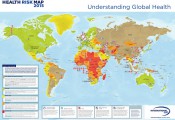International Health Risk Map outlines world’s safest and most dangerous places for health care
- International SOS published International Health Risk Map showing the standard of healthcare around the world
- Outlines which countries have the best and worst emergency healthcare
- Greece, Iceland, Japan, the UK and US among best countries for medical treatment
- Popular holiday spots from Thailand to Egypt, Turkey and Mexico among countries with ‘medium’ or ‘high’ risk
- North Korea, Iraq, Afghanistan and Syria are unsurprisingly the countries with the worst healthcare
A map of the riskiest destinations for contracting an illness or being involved in an accident has been published by health organisation International SOS.
The Health Risk Map 2015 ranks destinations in five categories, in order to help companies and travellers understand the risks they face in different countries when getting medical treatment.
Categories include low risk, medium risk, high risk and extreme risk, with another category for large, rapidly developing countries.
The International SOS Health Risk map shows the countries where healthcare is high quality and the places where travellers are at risk
While Europe, North America and Australia are understandably among the countries offering the highest levels of medical care, there are some popular holiday destinations where travellers are at risk.
Mexico, Turkey, Morocco and Thailand are among the holiday hotspots declared as ‘medium risk‘ on the map, with some risk of diseases and emergency medical care described as ‘adequate’.
However, holidaymakers are recommended to search out quality medical providers and informed that in some severe cases they may need to be evacuated to another country.
High-risk countries that are favorite holiday destinations include Tanzania, Egypt, Laos and Cambodia, with tourists recommended to transfer to a high-quality facility if they are taken ill and warned that any hospitalisation may result in an international evacuation.
Countries deemed high risk have limited medical capabilities and access to prescription drugs and have a risk of serious infectious diseases such as cholera, typhoid or dengue fever.
The most crisis-hit countries include many African nations as well as Afghanistan and North Korea as well as areas that have been affected by natural disasters in recent years such as Haiti.
International SOS assessed the assessed various factors including the quality of medical and dental care, access to prescription drugs, prevalence of infectious diseases and cultural, administrative and language barriers.
According to the map, the low-risk countries, with high-quality emergency health and dental care, a range of prescription drugs available and low risk of infectious disease include the US, Australia, New Zealand, Greece, the UK, Spain, France and the rest of western Europe.
However, the overall level of healthcare offered in countries around the world reiterates the importance of travel insurance.
For tourists who fall ill or are injured in countries where it is recommended they seek the highest-quality healthcare centres for treatment, medical costs can soon soar. However, with health insurers, worried holidaymakers can contact emergency helplines to find the best available medical centre available to them as part of their policy.
Low-risk countries include the US, UK, Australia and Greece while extreme risk countries include Afghanistan, Syria, North Korea and Haiti
A new category was included on the map this year to highlight the disparity of care available in ‘large rapidly developing countries’, such as China, Brazil and Russia, where access to quality healthcare differs hugely between cities and more rural outposts.
Doug Quarry, Medical Director, Medical Information and Analysis at International SOS said: ‘Recent International SOS data shows that over 40 percent of our medical cases occur in countries classed as ‘High’ or ‘Extreme’ risk.
“This is a significant increase from less than 25 percent in 2010. Preparation of travellers, including a risk assessment, education and health check programme for staff, will reduce the need for intervention after travel.”
‘This is especially important for people traveling to high and extreme risk countries. Health Risk Map 2015 is just one of the many tools that can help organisations plan and prepare for operations around the world.”
International SOS works as a health security risk services company and has 53 clinics worldwide, 40 of which operate in areas where there are gaps in quality of medical care.
Source: www.dailymail.co.uk


